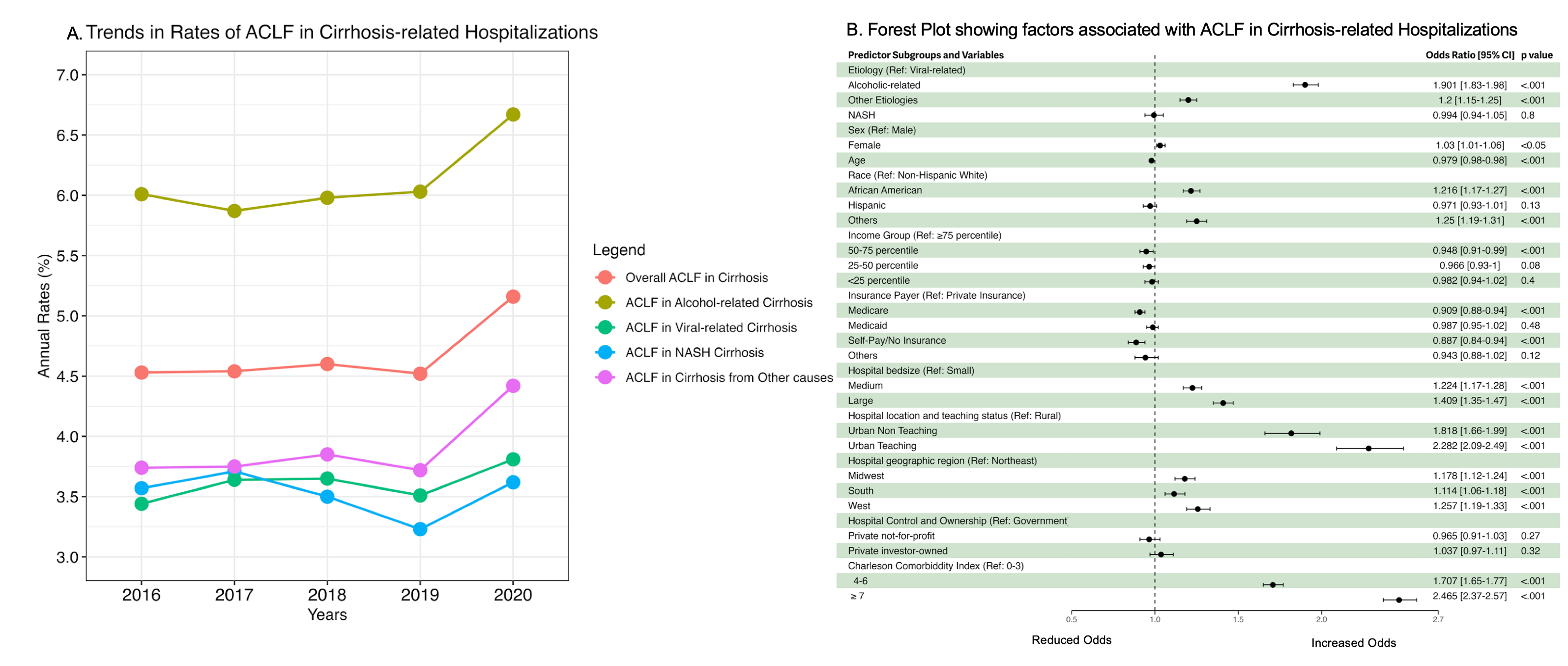Tuesday Poster Session
Category: Liver
P5951 - Trends and Predictors of Acute-on-Chronic Liver Failure Among Cirrhosis-Related Hospitalizations in the United States: An Updated Nationwide Analysis
Tuesday, October 28, 2025
10:30 AM - 4:00 PM PDT
Location: Exhibit Hall

Mansi Mody, MBBS (she/her/hers)
M.P. Shah Government Medical College
Bharuch, Gujarat, India
Presenting Author(s)
Mansi Mody, MBBS1, Vishal Doshi, MBBS2, Apoorva Doshi, MD3, Sushrut Ingawale, MD4, Jenish Patel, MBBS5
1M.P. Shah Government Medical College, Bharuch, Gujarat, India; 2Seth Gordhandas Sundardas Medical College and KEM Hospital, Bharuch, Gujarat, India; 3Jacobi Medical Center, New York City, NY; 4Quinnipiac University - Frank H. Netter, MD School of Medicine / St. Vincent's Medical Center, Bridgeport, CT; 5M . P . Shah Government Medical College, Surat, Gujarat, India
Introduction: Acute-on-chronic liver failure (ACLF) is a critical condition marked by acute deterioration in cirrhosis with multi-system organ failure, leading to high morbidity and mortality. Despite reports of increasing cirrhosis prevalence, contemporary data on rates of ACLF and etiological trends remain scarce.
Methods: Using the National Inpatient Sample (2016–2020), we identified adult patients admitted for cirrhosis-related conditions and categorized them by etiology: viral-related, alcohol-related (ALD), nonalcoholic steatohepatitis (NASH), and other causes. ACLF was defined as cirrhosis with ≥2 organ system failures: respiratory failure requiring mechanical ventilation, shock, grade ≥3 hepatic encephalopathy, or renal failure requiring dialysis/replacement therapy.
Trends in ACLF rates were analyzed using Cochrane-Armitage test and multivariable logistic regression identified predictors of ACLF among etiology, demographics and comorbidities (Charleson Comorbidity Index [CCI]) while using hospital characteristics as confounders.
Results: A total of 690,481 adult hospitalizations were included with 4.7% (n=32311) meeting the criteria for ACLF. The mean age was 60 years (SEM, ± 8) with 61% males and 62% non-Hispanic White (Table 1). The highest proportion of ACLF was in ALD (6%), followed by other causes (3.9%), viral-related (3.6%) and NASH-related (3.5%). Similarly, respiratory failure (82%) and shock (82%) were the most common organ system failures followed by renal failure (40%) and hepatic encephalopathy (20%).
The rates of ACLF significantly increased from 2016 to 2020 (4.53% vs 5.16%, p < .001). This trend was also observed across all etiologies with the most increase in ACLF arising from other causes (3.74% vs 4.42%, p < .001) (Figure 1).
Among various predictors, ALD (OR [95% CI]: 1.9 [1.83-1.98]), other causes (OR [95% CI]: 1.20 [1.15-1.25]), female sex (OR [95% CI]: 1.03 [1.01-1.06]), African-American race (AA) (OR [95% CI]: 1.22[1.17-1.27]), other races (OR [95% CI]: 1.25 [1.19-1.31]), CCI 4-6 (OR [95% CI]: 1.71 [1.65-1.77]) and CCI ≥ 7 (OR [95% CI]: 2.47 [2.37-2.57]) were significantly associated with increasing odds of developing ACLF (Figure 1).
Discussion: The rates of ACLF in cirrhosis-related hospitalizations continues to rise in the US with significant increases noted across all etiologies. Factors like ALD, female sex, AA race, and comorbidity burden are associated with higher odds of ACLF. The causal implication of these factors needs to be further studied.

Figure: Table 1.Baseline Characteristics of Cirrhosis-related Hospitalizations.

Figure: Figure 2. A: Trends in Rates of ACLF in Cirrhosis-related Hospitalizations. B: Forest Plot showing factors associated with ACLF in Cirrhosis-related Hospitalizations.
Disclosures:
Mansi Mody indicated no relevant financial relationships.
Vishal Doshi indicated no relevant financial relationships.
Apoorva Doshi indicated no relevant financial relationships.
Sushrut Ingawale indicated no relevant financial relationships.
Jenish Patel indicated no relevant financial relationships.
Mansi Mody, MBBS1, Vishal Doshi, MBBS2, Apoorva Doshi, MD3, Sushrut Ingawale, MD4, Jenish Patel, MBBS5. P5951 - Trends and Predictors of Acute-on-Chronic Liver Failure Among Cirrhosis-Related Hospitalizations in the United States: An Updated Nationwide Analysis, ACG 2025 Annual Scientific Meeting Abstracts. Phoenix, AZ: American College of Gastroenterology.
1M.P. Shah Government Medical College, Bharuch, Gujarat, India; 2Seth Gordhandas Sundardas Medical College and KEM Hospital, Bharuch, Gujarat, India; 3Jacobi Medical Center, New York City, NY; 4Quinnipiac University - Frank H. Netter, MD School of Medicine / St. Vincent's Medical Center, Bridgeport, CT; 5M . P . Shah Government Medical College, Surat, Gujarat, India
Introduction: Acute-on-chronic liver failure (ACLF) is a critical condition marked by acute deterioration in cirrhosis with multi-system organ failure, leading to high morbidity and mortality. Despite reports of increasing cirrhosis prevalence, contemporary data on rates of ACLF and etiological trends remain scarce.
Methods: Using the National Inpatient Sample (2016–2020), we identified adult patients admitted for cirrhosis-related conditions and categorized them by etiology: viral-related, alcohol-related (ALD), nonalcoholic steatohepatitis (NASH), and other causes. ACLF was defined as cirrhosis with ≥2 organ system failures: respiratory failure requiring mechanical ventilation, shock, grade ≥3 hepatic encephalopathy, or renal failure requiring dialysis/replacement therapy.
Trends in ACLF rates were analyzed using Cochrane-Armitage test and multivariable logistic regression identified predictors of ACLF among etiology, demographics and comorbidities (Charleson Comorbidity Index [CCI]) while using hospital characteristics as confounders.
Results: A total of 690,481 adult hospitalizations were included with 4.7% (n=32311) meeting the criteria for ACLF. The mean age was 60 years (SEM, ± 8) with 61% males and 62% non-Hispanic White (Table 1). The highest proportion of ACLF was in ALD (6%), followed by other causes (3.9%), viral-related (3.6%) and NASH-related (3.5%). Similarly, respiratory failure (82%) and shock (82%) were the most common organ system failures followed by renal failure (40%) and hepatic encephalopathy (20%).
The rates of ACLF significantly increased from 2016 to 2020 (4.53% vs 5.16%, p < .001). This trend was also observed across all etiologies with the most increase in ACLF arising from other causes (3.74% vs 4.42%, p < .001) (Figure 1).
Among various predictors, ALD (OR [95% CI]: 1.9 [1.83-1.98]), other causes (OR [95% CI]: 1.20 [1.15-1.25]), female sex (OR [95% CI]: 1.03 [1.01-1.06]), African-American race (AA) (OR [95% CI]: 1.22[1.17-1.27]), other races (OR [95% CI]: 1.25 [1.19-1.31]), CCI 4-6 (OR [95% CI]: 1.71 [1.65-1.77]) and CCI ≥ 7 (OR [95% CI]: 2.47 [2.37-2.57]) were significantly associated with increasing odds of developing ACLF (Figure 1).
Discussion: The rates of ACLF in cirrhosis-related hospitalizations continues to rise in the US with significant increases noted across all etiologies. Factors like ALD, female sex, AA race, and comorbidity burden are associated with higher odds of ACLF. The causal implication of these factors needs to be further studied.

Figure: Table 1.Baseline Characteristics of Cirrhosis-related Hospitalizations.

Figure: Figure 2. A: Trends in Rates of ACLF in Cirrhosis-related Hospitalizations. B: Forest Plot showing factors associated with ACLF in Cirrhosis-related Hospitalizations.
Disclosures:
Mansi Mody indicated no relevant financial relationships.
Vishal Doshi indicated no relevant financial relationships.
Apoorva Doshi indicated no relevant financial relationships.
Sushrut Ingawale indicated no relevant financial relationships.
Jenish Patel indicated no relevant financial relationships.
Mansi Mody, MBBS1, Vishal Doshi, MBBS2, Apoorva Doshi, MD3, Sushrut Ingawale, MD4, Jenish Patel, MBBS5. P5951 - Trends and Predictors of Acute-on-Chronic Liver Failure Among Cirrhosis-Related Hospitalizations in the United States: An Updated Nationwide Analysis, ACG 2025 Annual Scientific Meeting Abstracts. Phoenix, AZ: American College of Gastroenterology.
